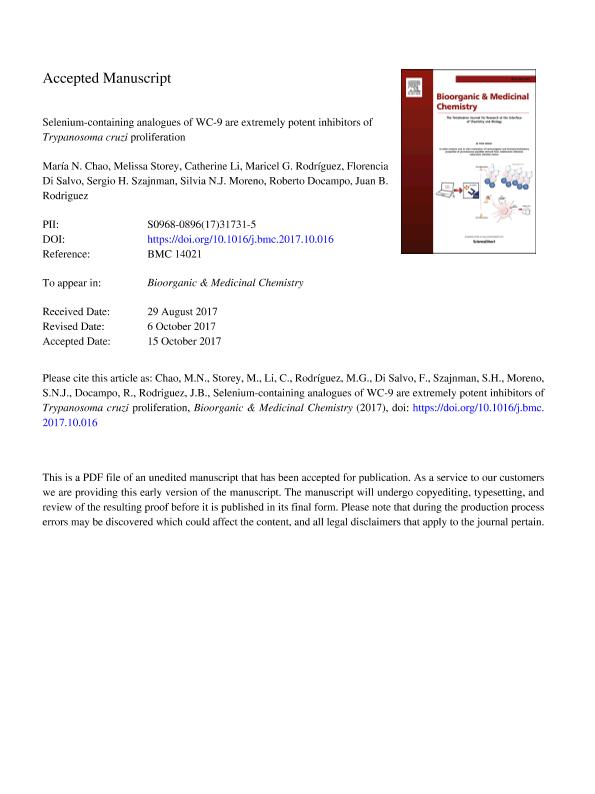Mostrar el registro sencillo del ítem
dc.contributor.author
Chao, Maria Noelia

dc.contributor.author
Storey, Melissa
dc.contributor.author
Li, Catherine
dc.contributor.author
Rodriguez, Maricel Gabriela

dc.contributor.author
Di Salvo, Florencia

dc.contributor.author
Szajnman, Sergio Hernan

dc.contributor.author
Moreno, Silvia N. J.
dc.contributor.author
Docampo, Roberto
dc.contributor.author
Rodriguez, Juan Bautista

dc.date.available
2018-09-10T16:48:20Z
dc.date.issued
2017-10
dc.identifier.citation
Chao, Maria Noelia; Storey, Melissa; Li, Catherine; Rodriguez, Maricel Gabriela; Di Salvo, Florencia; et al.; Selenium-containing analogues of WC-9 are extremely potent inhibitors of Trypanosoma cruzi proliferation; Pergamon-Elsevier Science Ltd; Bioorganic & Medicinal Chemistry; 25; 24; 10-2017; 6435-6449
dc.identifier.issn
0968-0896
dc.identifier.uri
http://hdl.handle.net/11336/58899
dc.description.abstract
The obligate intracellular parasite, Trypanosoma cruzi is the etiologic agent of Chagas disease or American trypanosomiasis, which is the most prevalent parasitic disease in the Americas. The present chemotherapy to control this illness is still deficient particularly in the chronic stage of the disease. The ergosterol biosynthesis pathway has received much attention as a molecular target for the development of new drugs for Chagas disease. Especially, inhibitors of the enzymatic activity of squalene synthase were shown to be effective compounds on T. cruzi proliferation in in vitro assays. In the present study we designed, synthesized and evaluated the effect of a number of isosteric analogues of WC-9 (4-phenoxyphenoxyethyl thiocyanate), a known squalene synthase inhibitor, on T. cruzi growth in tissue culture cells. The selenium-containing derivatives turned out to be extremely potent inhibitors of T. cruzi growth. Certainly, 3-phenoxyphenoxyethyl, 4-phenoxyphenoxyethyl, 4-(3-fluorophenoxy)phenoxyethyl, 3-(3-fluorophenoxy)phenoxyethyl selenocyanates and (±)-5-phenoxy-2-(selenocyanatomethyl)-2,3-dihydrobenzofuran arose as relevant members of this family of compounds, which exhibited effective ED50 values of 0.084 µM, 0.11 µM, 0.083, µM, 0.085, and 0.075 µM, respectively. The results indicate that compounds bearing the selenocyanate moiety are at least two orders of magnitude more potent than the corresponding skeleton counterpart bearing the thiocyanate group. Surprisingly, these compounds exhibited excellent selectively index values ranging from 900 to 1800 making these molecules promising candidates as antiparasitic agents.
dc.format
application/pdf
dc.language.iso
eng
dc.publisher
Pergamon-Elsevier Science Ltd

dc.rights
info:eu-repo/semantics/openAccess
dc.rights.uri
https://creativecommons.org/licenses/by-nc-sa/2.5/ar/
dc.subject
Trypanosoma Cruzi
dc.subject
Squalene Synthase
dc.subject
Chagas Disease
dc.subject
Antiparasitic Agents
dc.subject.classification
Otras Ciencias Químicas

dc.subject.classification
Ciencias Químicas

dc.subject.classification
CIENCIAS NATURALES Y EXACTAS

dc.title
Selenium-containing analogues of WC-9 are extremely potent inhibitors of Trypanosoma cruzi proliferation
dc.type
info:eu-repo/semantics/article
dc.type
info:ar-repo/semantics/artículo
dc.type
info:eu-repo/semantics/publishedVersion
dc.date.updated
2018-09-04T19:02:08Z
dc.journal.volume
25
dc.journal.number
24
dc.journal.pagination
6435-6449
dc.journal.pais
Estados Unidos

dc.journal.ciudad
Oxford
dc.description.fil
Fil: Chao, Maria Noelia. Consejo Nacional de Investigaciones Científicas y Técnicas. Oficina de Coordinación Administrativa Ciudad Universitaria. Unidad de Microanálisis y Métodos Físicos en Química Orgánica. Universidad de Buenos Aires. Facultad de Ciencias Exactas y Naturales. Unidad de Microanálisis y Métodos Físicos en Química Orgánica; Argentina
dc.description.fil
Fil: Storey, Melissa. University of Georgia; Estados Unidos
dc.description.fil
Fil: Li, Catherine. University of Georgia; Estados Unidos
dc.description.fil
Fil: Rodriguez, Maricel Gabriela. Consejo Nacional de Investigaciones Científicas y Técnicas. Oficina de Coordinación Administrativa Ciudad Universitaria. Instituto de Química, Física de los Materiales, Medioambiente y Energía. Universidad de Buenos Aires. Facultad de Ciencias Exactas y Naturales. Instituto de Química, Física de los Materiales, Medioambiente y Energía; Argentina
dc.description.fil
Fil: Di Salvo, Florencia. Consejo Nacional de Investigaciones Científicas y Técnicas. Oficina de Coordinación Administrativa Ciudad Universitaria. Instituto de Química, Física de los Materiales, Medioambiente y Energía. Universidad de Buenos Aires. Facultad de Ciencias Exactas y Naturales. Instituto de Química, Física de los Materiales, Medioambiente y Energía; Argentina
dc.description.fil
Fil: Szajnman, Sergio Hernan. Consejo Nacional de Investigaciones Científicas y Técnicas. Oficina de Coordinación Administrativa Ciudad Universitaria. Unidad de Microanálisis y Métodos Físicos en Química Orgánica. Universidad de Buenos Aires. Facultad de Ciencias Exactas y Naturales. Unidad de Microanálisis y Métodos Físicos en Química Orgánica; Argentina
dc.description.fil
Fil: Moreno, Silvia N. J.. University of Georgia; Estados Unidos
dc.description.fil
Fil: Docampo, Roberto. University of Georgia; Estados Unidos
dc.description.fil
Fil: Rodriguez, Juan Bautista. Consejo Nacional de Investigaciones Científicas y Técnicas. Oficina de Coordinación Administrativa Ciudad Universitaria. Unidad de Microanálisis y Métodos Físicos en Química Orgánica. Universidad de Buenos Aires. Facultad de Ciencias Exactas y Naturales. Unidad de Microanálisis y Métodos Físicos en Química Orgánica; Argentina
dc.journal.title
Bioorganic & Medicinal Chemistry

dc.relation.alternativeid
info:eu-repo/semantics/altIdentifier/doi/https://dx.doi.org/10.1016/j.bmc.2017.10.016
dc.relation.alternativeid
info:eu-repo/semantics/altIdentifier/url/https://www.sciencedirect.com/science/article/pii/S0968089617317315
Archivos asociados
